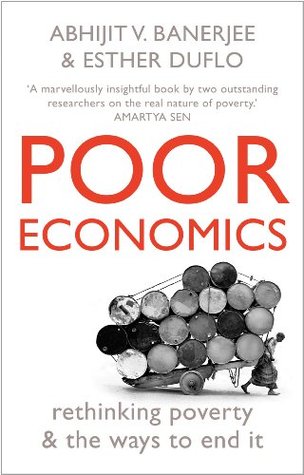More on this book
Community
Kindle Notes & Highlights
Poor countries are poor because they are hot, infertile, malaria infested, often landlocked; this makes it hard for them to be productive without an initial large investment to help them deal with these endemic problems.
that poverty leads to an intolerable waste of talent. As he puts it, poverty is not just a lack of money; it is not having the capability to realize one’s full potential as a human being.10
“Poverty is not just lack of money; it is not having the capability to realize one’s full potential as a human being” — These are not just words to be highlighted in the book, but something that made me go 🤯
children should be given meals at school to encourage their parents to send them to school regularly.
This is the underlying philosophy behind Jeffrey Sachs’s Millennium Villages Project. The villagers in the fortunate villages get free fertilizer, school meals, working health clinics, computers in their school, and much more. Total cost: half a million dollars a year per village.
Adding onto this idea, it would also be viable for the Indian govt to push “free insurance” to the families who send their kids to school. — just a random thought, should research more on this if it could be a viable solution.
There will be a poverty trap whenever the scope for growing income or wealth at a very fast rate is limited for those who have too little to invest, but expands dramatically for those who can invest a bit more. On the other hand, if the potential for fast growth is high among the poor, and then tapers off as one gets richer, there is no poverty trap.
The delivery of food aid on a massive scale is a logistical nightmare. In India, it is estimated that more than one-half of the wheat and over one-third of the rice get “lost” along the way, including a good fraction that gets eaten by rats.
The inability of the poor to feed themselves properly is also one of the most frequently cited root causes of a poverty trap.
The intuition is powerful:The poor cannot afford to eat enough; this makes them less productive and keeps them poor.
In Udaipur, for example, we find that the typical poor household could spend up to 30 percent more on food than it actually does if it completely cut expenditures on alcohol, tobacco, and festivals. The poor seem to have many choices, and they don’t elect to spend as much as they can on food.
When very poor people get a chance to spend a little bit more on food, they don’t put everything into getting more calories. Instead, they buy better-tasting, more expensive calories.
What is happening to nutrition in India today is another puzzle. The standard media story about it is about the rapid rise of obesity and diabetes as the urban upper-middle classes get richer.
Despite rapid economic growth, there has been a sustained decline in per capita calorie consumption;
moreover, the consumption of all other nutrients except fat also appears to have declined among all groups, even the poorest. Today, more than three-fourths
of the population live in households whose per capita calorie consumption is less than 2,100 calories in urban areas and 2,400 in rural areas—numbers that are often cited as “minimum requiremen...
This highlight has been truncated due to consecutive passage length restrictions.
the decline in calorie consumption happened precisely when the price of food was going down.


